Steamboat Springs, CO
Strategic Roadmap Positions Steamboat Springs to Maximize Federal Water Infrastructure Funding Our Approach Project OutcomesProject Goal
The City of Steamboat Springs and Mount Werner Water & Sanitation District collectively serve water and wastewater services to over 13,000 people across 9.9 square miles in northwest Colorado. Since the early 2000’s, the City and District's treated water demands have continued to decrease, despite population growth, due to improved conservation and water use efficiency measures. Building on this progress, Steamboat Springs sought to secure funding from the American Rescue Plan Act and the Bipartisan Infrastructure Law to implement water infrastructure and resiliency projects identified in earlier planning efforts to address drought, wildfires, among other challenges. However, the City felt overwhelmed by the multitude of funding and financing options, demanding application requirements, and urgent pressure to capitalize on these unprecedented funds.
Our Approach
WaterNow Alliance partnered with the City of Steamboat Springs to develop a strategy for securing funding and financing available under the American Rescue Plan Act (ARPA) and the Bipartisan Infrastructure Law (BIL) to support the City’s water infrastructure and resiliency projects. To achieve this, WaterNow identified the City’s priority projects and researched funding and financing opportunities that aligned with them. WaterNow then created a roadmap for pursuing funding opportunities, which offers step-by-step guidance on how to pursue the most suitable opportunities for these high-priority projects.
Outcomes
By identifying priority projects, building a knowledge base of available options under ARPA and BIL, and creating a roadmap for how to secure funding, Steamboat Springs can better focus on the most suitable funding opportunities for their water infrastructure needs. The roadmap will help the City achieve its water management goals by enabling it to focus on securing funding that aligns with its priorities, budget, administrative capacity, experience, overhead, matching funds, regulatory context, program competitiveness, relevant capital improvement plans, and debt issuances, rather than simply searching for funding opportunities.








